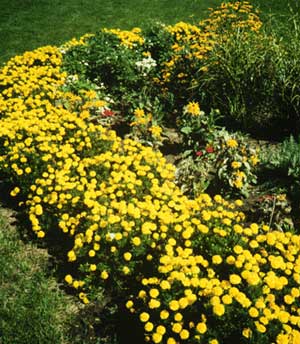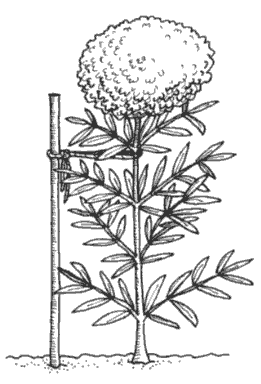The care information provided in this section represents the kind of practical advice is available for all the plants in this web site if you subscribe to the monthly customized newsletter Yardener’s Advisor.
 |
Watering
Marigolds do best and are healthiest and seldom need watering if they are growing in soil well amended with organic materials and if they are well mulched. Then if there is a 10 day or two week dry spell water them thoroughly and let the soil nearly dry out before the next watering. Avoid sprinkling or otherwise wetting the blossoms of the large-flowered American or hybrid types. They tend to become waterlogged and turn brown and mushy. If you use an overhead sprinkler, water only early in the day to allow foliage to dry well. Soaker hose systems leak water directly onto the soil to forestall mildew problems on marigold foliage. Do not allow the soil to completely dry out during drought conditions. In this situation marigolds may suddenly die. For information on products see the file on Choosing Watering Equipment
Fertilizing
Marigolds do not want a lot of fertilizer, especially if they are growing in good soil containing lots of organic material. In that case, they want only a light feeding in the spring when the seedlings are set out. Too rich a diet will cause them to produce lots of foliage instead of blossoms. So in the spring sprinkle a slow-acting granular fertilizer over the planting area for the rain to soak in--about 1 teaspoon per plant is a rough gauge. This will be sufficient for the basic needs of the marigolds all season. For more information see the file Choosing Fertilizers.
Mulching
As soon as the marigold seedlings are tall enough, spread a 2 or 3 inch layer of some organic material such as chopped leaves, dried grass or wood chips on the soil around annuals like marigolds. This mulch suppresses weeds, reduces evaporation of moisture from the soil, cools the soil, and improves the soil as it decomposes.
Click here for more information on Using Mulch .
Pruning/Grooming
As a group, marigolds are wonderfully self-reliant, needing very little attention over the season. American and French marigolds benefit from deadheading. This practice of snipping off the dead blossoms prevents the plants from forming seeds, thus stimulating the production of more blooms. It also keeps the plants looking attractive.
 |
Staking Marigolds
Tall American and triploid type marigolds need support to protect them against heavy rain, wind and passers-by. Choose unobtrusive green stakes available at garden centers or find straight, sturdy sticks that are at least as tall as the eventual height of the marigold plants. Tie each plant to a stake which has been inserted into the soil next to the stem. Use soft fabric or plastic ties made for this purpose and loop them around the stake, then around the plant stem, then back to the stake to be fastened. Stakes should be slightly shorter than the plants, so that they do not show.

